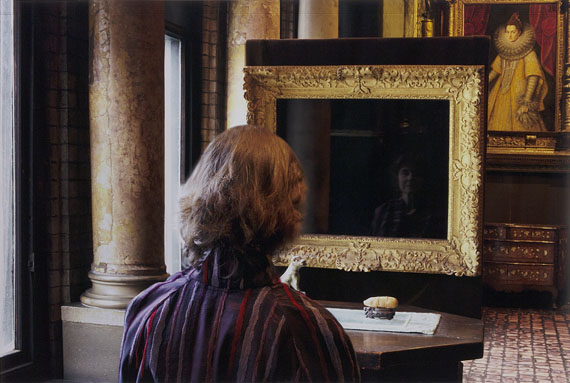
© Sophie Calle / ADAGP Paris 2019
Photo: Claire Dorn / Courtesy Perrotin
Sophie Calle »
Un Certain Regard
Exhibition: 8 Jun – 25 Aug 2019
Fri 7 Jun 18:00
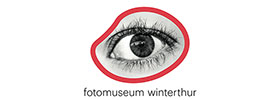
Fotomuseum Winterthur
Grüzenstr. 44+45
8400 Winterthur
+41 (0)52-2341060
info@fotomuseum.ch
www.fotomuseum.ch
Tue, Thu, Fri 11-17; Wed 11-20; Sat-Sun 11-18
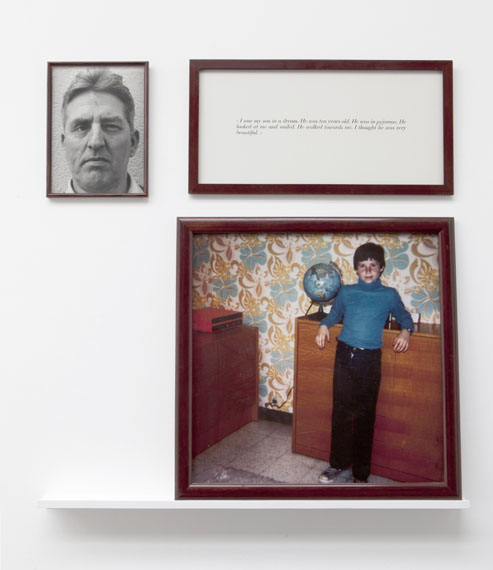
"I saw my son in a dream. He was ten years old. He was in pyjamas. He looked at me and smiled.
He walked towards me. I thought he was very beautiful"
Sophie Calle: "The Blind. My son, 1986"
© Sophie Calle / ADAGP Paris 2019; Courtesy the artist & Perrotin
Sophie Calle
"Un certain regard"
Exhibition: 8 June – 25 August, 2019
Opening: Friday, 7 June, 6-10pm
Sophie Calle, born in Paris in 1953, is a conceptual artist, photographer and film-maker. Her work has a unique individual style, a distinct blend of meticulous research, interviews and combinations of image and text. Calle’s artistic approach does not strive for perfection or objectivity; rather the artist seeks out a personal angle, a way into her material in which the in-between space becomes a key element. Her projects are nested in a close-knit web of references and cross-references in which the boundaries between reality and fiction, between
private and public and between past and present are dissolved.
The exhibition "Un certain regard" comprises five work series that deal thematically with the representation of absence: with images
that have disappeared and been removed from sight. The exhibition combines series – most of them created over the last fifteen years – that translate Calle’s creative output into a distinctive and singular experience, to be presented now for the first time in Switzerland in a monographic exhibition.
For "Les Aveugles" (1986), Sophie Calle interviewed blind people and asked them to describe their image of beauty. The portraits of the interviewees are accompanied by their responses to her questions and by photos that the artist took to relate to the descriptions. For La Dernière Image (2010), Calle interviewed people in Istanbul who had lost their sight, talking to them about the final visual
image they recalled before going blind. Here too the portraits of the protagonists and excerpts from the interviews are combined with photographs that help recreate the situation described. Both series break with one-dimensional patterns of perception and point to the complex and interwoven realities of imagination and representation.
In "Que voyez-vous ?" (2013), Sophie Calle turned her attention to the absence of concrete objects. In 1990, thirteen artworks were stolen from the Isabella Stewart Gardner Museum in Boston. Since then the museum has displayed empty picture frames in their place. Calle portrays museum visitors standing in front of five of these "placeholders" and asks, "What do you see?" The answers are reproduced in full and hang beneath the portraits – some of the gallery-goers remain unaware that what they are seeing is a "blank". Instead, the act of contemplating the vacant space turns it into something worth looking at. In "Detachment" (1996), Calle compiles photographs of non-places: vacated plinths, empty expanses of grass, square holes in concrete slabs. They are historical witnesses of, and testimony to, the changes that went hand in hand with the
reunification of Germany in 1989. All the symbols representing the former GDR have been removed. Under the pictures are transcripts of the responses of passers-by whom Calle interviewed about their memories and sense of connection to the erstwhile statues and monuments.
"Parce que" (2018) in turn shows a series of photographs, each of which is covered by a predominately dark curtain bearing a quotation printed in white. All the quotes begin with the words “Parce que” (“Because”) and explain the thinking that prompted Calle to take the photo that is mounted below the text. The exhibition visitor can lift the curtain and look at the photograph. No inferences can be drawn about the pictures from the explanations – for the most part vague and very personal – which the viewer will have read before looking at each image.
Calle’s meticulously thought-out idea questions the supremacy of the word and shows the degree of interdependence between what is said and what is seen. Sophie Calle’s oeuvre has been displayed in numerous solo and group exhibitions for over forty years, appearing in a variety of international settings, ranging from the Centre Pompidou, Paris (2003–2004), and Palais des Beaux-Arts, Brussels (2009), to the Isabella Stewart Gardner Museum, Boston (2013), and Nagasaki Prefectural Art Museum, Nagasaki (2016). In 2007, Sophie Calle represented France at the Venice Biennale and received the prestigious Hasselblad Award in 2010.
The exhibition is produced by ARTER and kindly supported by Ringier AG, Landis & Gyr Foundation, S. Eustachius-Foundation and Else v. Sick Foundation.
"Sophie Calle – Un certain regard" is curated by Nadine Wietlisbach and has been developed as the first part in a two-part exhibition in cooperation with Kunstmuseum Thun. "Sophie Calle – Regard incertain" will be shown at Kunstmuseum Thun from 7 September – 1 December, 2019.
ACCOMPANYING PROGRAMME
17 July 2019, 18:30
Special guided tour with Dr. Gesa Schneider, director Literaturhaus Zürich, and Nadine Wietlisbach on the combination of text and image and the spaces in between.
24 August 2019, 16:00
Special guided tour with Michael Fehr, narrator, and Nadine Wietlisbach on seeing and not seeing, memories and sensory perception.�
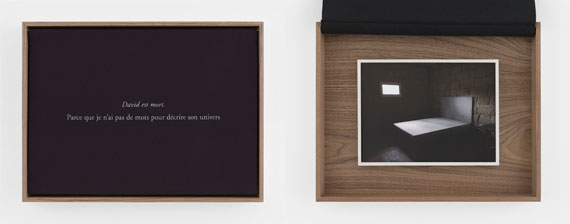
Sophie Calle, Parce que (Because), David, 2018
© Sophie Calle / ADAGP Paris 2019
Photo: Claire Dorn / Courtesy Perrotin
Sophie Calle
"Un certain regard"
Ausstellung: 8. Juni bis 25. August 2019
Eröffnung: Freitag, 7. Juni, 18 - 22 Uhr
Sophie Calle, 1953 in Paris geboren, ist gleichermassen Konzeptkünstlerin, Fotografin und Filmemacherin. Ihr Oeuvre weist einen einzigartigen Stil auf, der sich durch akribische Recherchen, Interviewarbeiten und Bild-Text-Kombinationen auszeichnet. Calles künstlerischer Ansatz ist weder durch Perfektion noch Objektivität geprägt, vielmehr sucht die Künstlerin einen persönlichen
Zugang, in dem die Lücke zum zentralen Element wird. Ihre Projekte fügen sich in ein enges Netz an Referenzen und Querverweisen ein, in denen sich die Grenzen zwischen Realität und Fiktion, dem Privaten und dem Öffentlichen, sowie dem Vergangenen und dem Jetzt auflösen.
Die im Fotomuseum Winterthur präsentierte Ausstellung "Un certain regard" umfasst fünf Werkserien, die sich thematisch mit verschwundenen oder fehlenden Bildern auseinandersetzen beziehungsweise mit der Repräsentation des Abwesenden. Die Ausstellung vereint Serien, die vor allem Calles Schaffen der letzten fünfzehn Jahre in ein einzigartiges Ausstellungserlebnis überführen und erstmals in der Schweiz in einer monografischen Ausstellung gezeigt werden.
Für "Les Aveugles" ( 1986) interviewte Sophie Calle Blinde und bat sie, ihr Bild von Schönheit zu beschreiben. Die Porträts der Interviewten werden von ihren Antworten sowie von Fotografien, die Calle den Beschreibungen nachempfunden hat, begleitet. Für "La Dernière Image" (2010) interviewte Calle Erblindete in Istanbul zu ihrer Erinnerung an das letzte visuelle Bild, bevor sie ihr Augenlicht verloren. Auch hier werden die Porträts und Zitate der Protagonist_innen mit Fotografien vereint, in denen die beschriebene Situation nachempfunden ist. Beide Serien brechen mit eindimensionalen Wahrnehmungsmustern und verweisen auf die komplexen und miteinander verwobenen Realitäten von Abgebildetem und Imaginiertem.
Für "Que voyez-vous ?" (2013) wendete sich Sophie Calle der Absenz konkreter Objekte zu. 1990 wurden aus dem Isabella Stewart Gardner Museum in Boston dreizehn Kunstwerke gestohlen. An ihrer Stelle zeigt das Museum seither leere Bilderrahmen. Calle portraitiert Museumsbesucher_innen vor fünf solcher Platzhalter und fragt: "Was sehen Sie?" Die Antworten sind in ihrer Gänze abgedruckt und hängen unter den Porträts – wobei manche der Betrachter_innen sich nicht bewusst sind, dass sie auf eine Leerstelle schauen. Stattdessen wird der leere Rahmen durch die Betrachtung betrachtungswürdig. In "Detachment" (1996) versammelt Calle Fotografien von Nicht-Orten: Abgeräumte Sockel, leerstehende Rasenflächen, quadratische Löcher in Betonplatten. Sie sind historische Zeugen und Zeugnisse des Wandels, der mit der Wiedervereinigung Deutschlands im Jahre 1989 einherging. Alle symbolischen Repräsentanten der ehemaligen DDR wurden entfernt. Unter den Fotografien finden sich Transkripte interviewter Passant_innen, die Calle zu ihren Erinnerungen und Verbindungen zu den ehemaligen Statuen und Monumenten befragte.
"Parce que" (2018) wiederum zeigt eine Serie an Fotografien, die jeweils durch einen meist dunklen Vorhang mit einem weiss aufgedruckten Zitat verdeckt sind. Alle Zitate beginnen mit dem Wort "Parce que" – "Weil" – und begründen Calles Entscheidung, das jeweils darunterliegende Foto aufgenommen zu haben. Die Besucher_innen können den Vorhang heben und die Fotografie betrachten. Die zumeist vagen und sehr persönlichen Erklärungen, die vor der Betrachtung eines Bildes gelesen werden, geben keine Rückschlüsse auf dieses. Mit ihrer akribischen Konzeption hinterfragt Calle die Vormachtstellung des Wortes und zeigt auf, wie sehr Gesagtes und Gesehenes voneinander abhängig sind.
Sophie Calles Ouevre ist seit über 40 Jahren in zahlreichen Einzel- und Gruppenausstellungen international vertreten, u.a. im Centre Pompidou, Paris (2003–2004), dem Palais des Beaux-Arts, Brüssel (2009), dem Isabella Stewart Gardner Museum, Boston (2013), und dem Nagasaki Prefectural Art Museum, Nagasaki (2016). 2007 vertrat Sophie Calle Frankreich auf der Venedig Biennale. Im Jahr 2010 erhielt sie den renommierten Hasselblad Award.
Die Ausstellung wurde von ARTER produziert und entstand mit freundlicher Unterstützung der Ringier AG, der Landis & Gyr Stiftung, der S. Eustachius-Stiftung sowie der Else v. Sick Stiftung.
"Sophie Calle – Un certain regard" wurde von Nadine Wietlisbach kuratiert und ist in Kooperation mit dem Kunstmuseum Thun als erster von zwei Teilen entstanden. "Sophie Calle – Regard incertain" ist vom 7. september bis 1. Dezember 2019 im Kunstmuseum Thun zu sehen.
BEGLEITPROGRAMM
17. Juli 2019, 18:30 Uhr
Spezialführung mit Dr. Gesa Schneider, Leiterin Literaturhaus Zürich, und Nadine Wietlisbach über die Verbindung von Text und Fotografie und den Raum zwischen den Zeilen.
24. August 2019, 16 Uhr
Spezialführung mit Michael Fehr, Erzähler, und Nadine Wietlisbach über das Sehen und Nicht-Sehen, über Erinnerung und Sinneswahrnehmungen.�
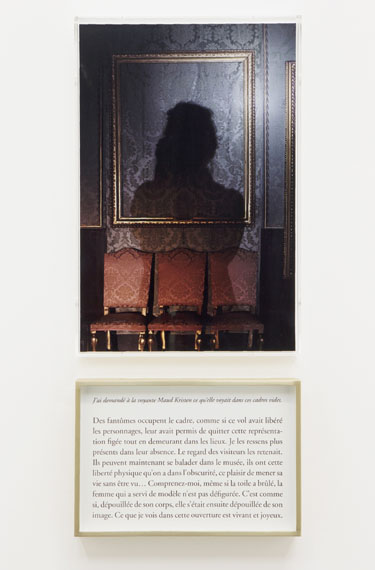
© Sophie Calle / ADAGP Paris
Photo: Claire Dorn / Courtesy Perrotin
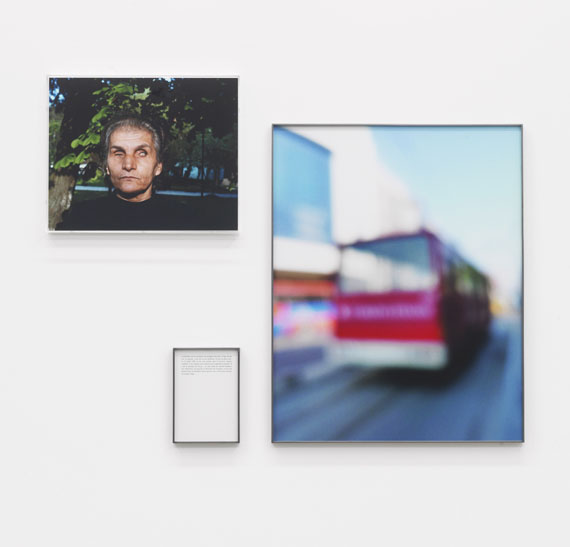
I asked them to describe the last image they saw. I photographed them.
I tried, whenever possible, to reproduce or recreate this last image.
I looked at Istanbul through their eyes.
Sophie Calle: "La Dernière Image. Aveugle au minibus", 2010
© Sophie Calle / ADAGP